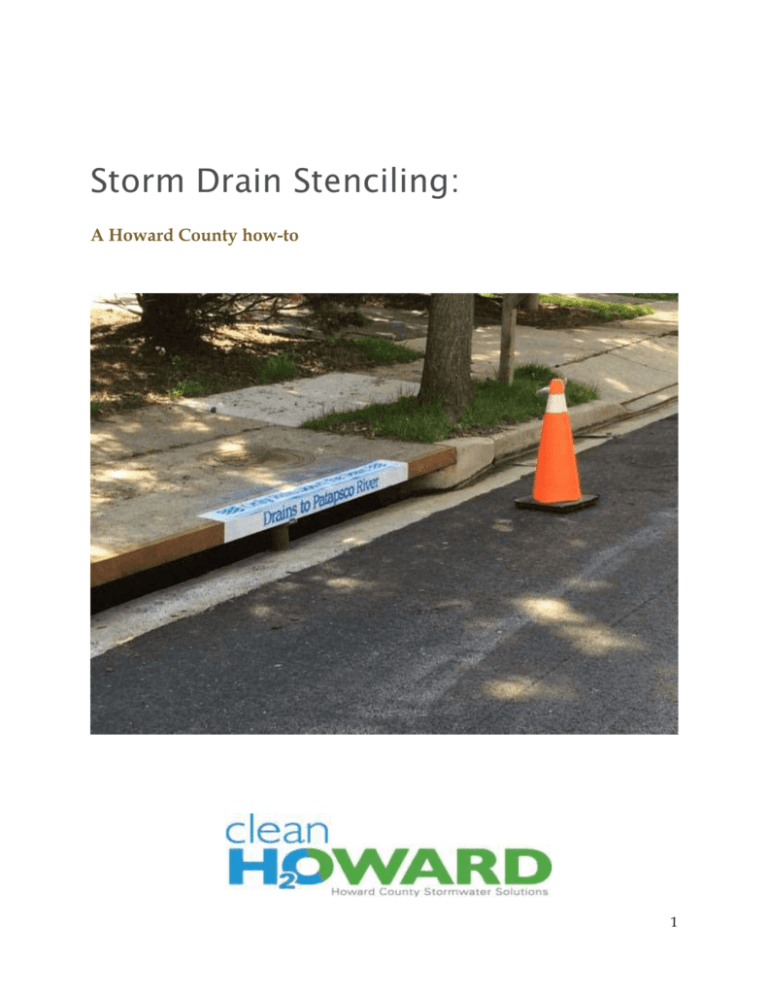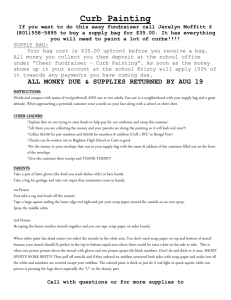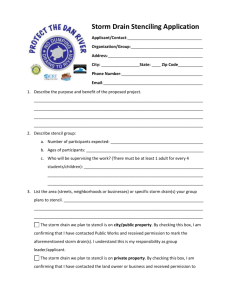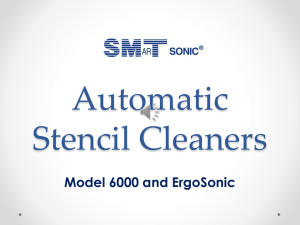Storm Drain Stenciling Program
advertisement

Storm Drain Stenciling: A Howard County how-to 1 Index Why should you stencil……………………..pg.3 Permission……………………………..……..pg.3-4 Materials…………………….………………..pg.4-5 Borrow the Stencils……………….…………pg.5-6 Stencil Directions……………………………pg. 5-8 Get painting…………………………………pg.6-8 Paint the Backgrounds……...……..pg. 8 Hand-Paint the Letters…………….pg.7 Spray-Paint the Letters…………….pg.7 Wrap up………………………..…………….pg.8 Why should you stencil? Did you know? Stormwater that runs off our rooftops, driveways, parking lots and streets, plus all the junk and pollution that flows along in it, usually finds its way to the nearest storm drain and then goes directly into a local stream - not to a water treatment plant. Stenciling storm drains can help raise awareness about the runoff connection to our local rivers and help keep pollution out of our streams, rivers and the Bay. Be part of the solutions, stencil storm drains and let people know that there should be “Only Rain Down the Drain.” Help keep our water bodies, like this beautiful section of the Little Patuxent River, clean by preventing pollution through storm drains! 2 Follow these directions to a tee, and you will have a beautiful project that both educates neighbors and protects our waterways. Permission You will need to get permission to stencil from the Howard County Bureau of Highways. Find the application here: http://www.howardcountymd.gov/departments.aspx?ID=414 . If there is a Home Owners Association (HOA) in your neighborhood, the Bureau of Highways also asks that you get a permission letter from them. Getting permission from your HOA is also a great way to increase the impact of your stenciling project—the more people know why you are doing it, the more effective it will be! The Bureau Highways will check the storm drain location and ownership and let you know if it’s alright to stencil. 3 Materials them off as you go Drop cloths or old sheets; 1/4 gallon of white, rust-resistant paint per storm drain 1 quart of royal blue, rust-resistant paint per 10 storm drains or 1 can royal blue non-toxic, CFC-free spray paint (older youth or adult groups only) per 6 storm drains Wire brush Paint stirrers Paint rollers/brushes. 4-6 inch paint rollers are best for the background white, but brushes also work. Small paint brushes are needed if you stencil the letters by hand. 2-3 paint brushes for lettering Masking tape Rubber or disposable gloves (non-latex is best) Safety vests 4 Screw driver to open paint cans Wet paint signs Paper towels or rags always come in handy Face masks (if you work with spray paint) Traffic cones for projects on busy streets Howard County loans the stencils, but does not supply other materials. You can buy these for your group, or you can find another group that has unused materials. Some hardware stores will also donate to volunteer groups. Contact them early to find out their donation procedures. Borrow the Stencils Once you’ve gotten permission from the Bureau of Highways, contact the Office of Environmental Sustainability to borrow the stencils. Polluted stormwater flushing down a storm drain will eventually make its way to the Chesapeake Bay, but first it will impact our local streams and rivers here in Howard County. So, we have made the stencils to represent our concern for the health of our local water resources. Instead of mentioning the Chesapeake Bay, our stencils refer to the Patapsco River and the Patuxent River. Find out which river your chosen storm drain flows to using this tool: https://data.howardcountymd.gov/GStreamFinder/GStreamFinder.asp Contact Rachel Beebe at (410) 313-0678 or rbeebe@howardcountymd.gov to make arrangements to borrow the stencils There are a limited number of stencils so don’t wait to the last minute! Stencil Directions Weather tips: Tip (weather concerns): Don’t stencil on a day below 50 F, if it has rained within 24 hours, or if rain is imminent. These will prevent the paint from drying properly. 1. Make sure you have all of the materials ready before you start. 5 2. Put down drop cloths to catch any materials or paint. 3. Scrub the stencil area of each drain with a wire brush to remove dirt and rust. 4. The stencils are designed to fit most Howard County drains. If the front side is too small, just stencil the top with the Drains to Patapsco or Drains to Patuxent stencil. If there are plants, junk or any other problems skip that drain and move on to the next storm drain on your list. If there are severe blockages, report to Rachel Beebe at 410-313-0678. Get Painting: Paint the Backgrounds 1. Place drop cloth around the stencil area. 2. As in the picture, “Only Rain Down the Drain” goes on the top (flat part looking down on the street) “Drains to Patapsco” or “Drains to Patuxent” goes on the front face (closest to the street). 3. Center the stencils and mark the left and right edges of the stencil with tape; this will show you how far you should paint the white background. Most of the time it will be the entire length, but some drains are extra big. 6 4. Remove the stencils and paint white background paint within the tape boundary lines 5. Attach a “wet paint” sign and send some of your team to do the same for the next storm drain. 6. Let the background paint dry (at least 15 minutes). 7. Don’t drip on the grass, road, or storm drain! Hand-Paint the Letters : Tip: Recommended method. Appropriate for all ages and costs less. 1. After the white paint is dry, securely tape on the stencils. Do not over-load the brush with paint; this will cause the letters to bleed outside of the stencils. 2. Dab paint on one letter at a time. Wearing gloves helps a lot –press the stencil against the drain with one hand and dab paint on with the other. Let the paint dry at least 15 minutes before carefully removing the stencil. 3. Peel the stencils off carefully so that you do not smudge the letters. 4. Let the paint dry completely (check paint can for drying time) and then remove the wet paint sign. 5. Place used brushes in a bucket and cover your paint cans to prevent paint drips as you move from one drain to the next. OR Spray Paint the Letters Tip: recommended for older youths and adults. 1. After the white paint is dry, securely tape on the stencils. The better attached, the less drips and smudges. 2. Place extra newspaper or drop cloths around the area to prevent spray from getting on the area surrounding stencil. 3. Follow directions on the can carefully!!! 4. Apply a series of thin coats, rather than focusing on each letter. This will help you to avoid drips and runs. 5. Release the trigger between passes. 7 6. Keep the can at least 6 inches away from the surface. 7. Make steady, horizontal passes. 8. Make sure you have enough spray paint in the can you plan to use for the whole storm drain. If you don’t and you have to take some time to switch cans, there will be a visible mark. 9. Save almost empty cans for smaller parts of the stencil (like the waves on the sides of the top stencil) . Wrap up Leave the area neat and dispose of any trash properly. Clean the stencils the best you can. Cleaning them with soap and water in a utility sink is best. Remember, not in the yard where the paint could run to the storm drain. Let the stencils dry completely! Make arrangements with the Office of Environmental Sustainability (Rachel Beebe, info below) to return the stencils so other volunteers can use them. Send an email to rbeebe@howardcountymd.gov letting us know how many drains you stenciled, the locations, and any comments or suggestions. Pictures are also great! Share your success! Let your neighbors, HOA, even the local paper know about your project. If you have a community newsletter or email chain, let them know about your great work. Stenciling Contact: Rachel Beebe, Howard County Office of Environmental Sustainability Phone: (410) 313-0678 Email: rbeebe@howardcountymd.gov THANK YOU! You are helping to keep your local streams, rivers, and the Bay clean. 8







